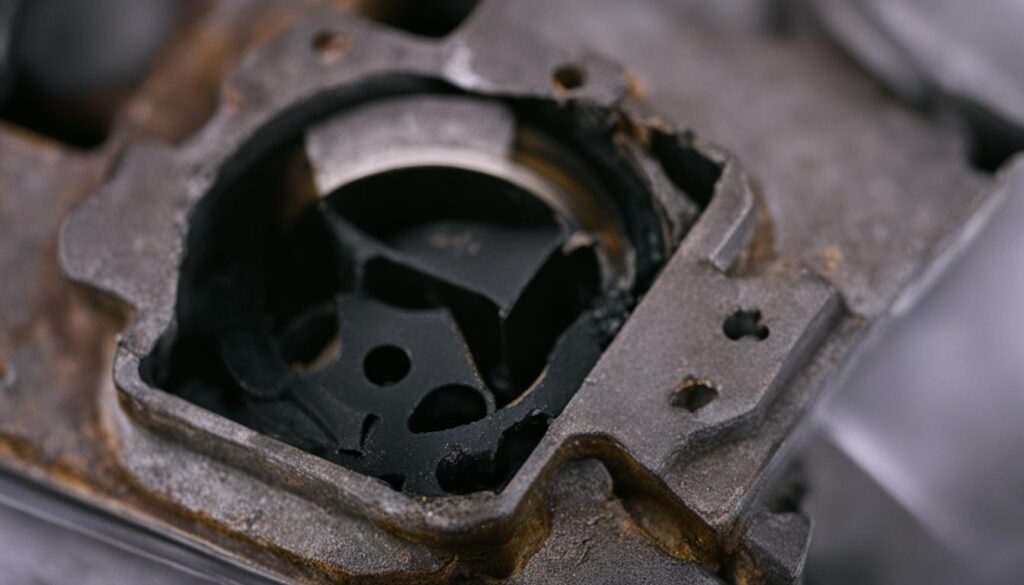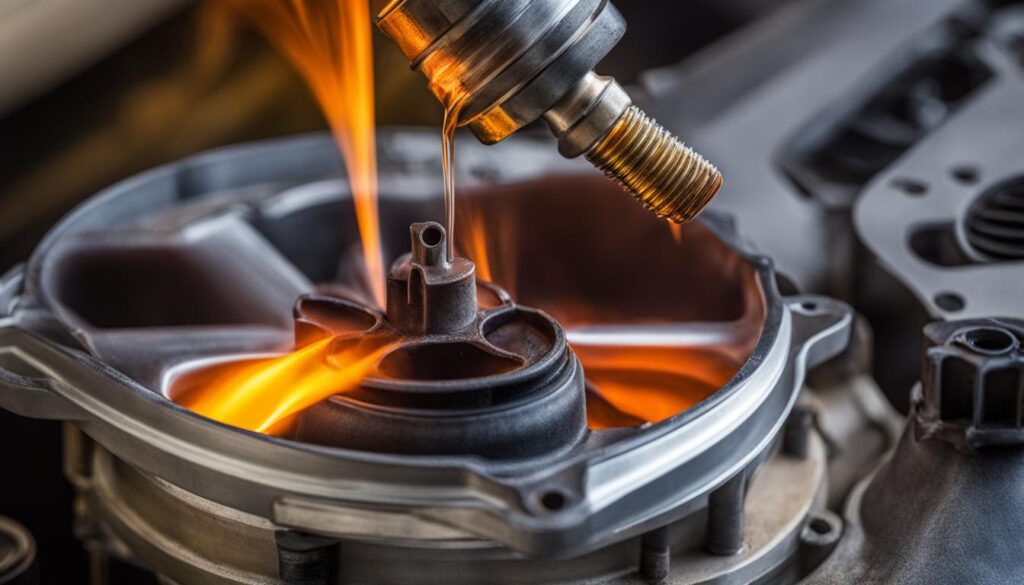The EGR valve, or exhaust gas recirculation valve, is an essential component of the engine management system. It recirculates exhaust gas back into the engine intake system to improve engine efficiency, reduce fuel consumption, and lower NOx emissions.
When it comes to EGR valve malfunction, there can be various causes and symptoms to watch out for. Understanding these issues is crucial in order to diagnose and fix any problems effectively.
One of the most common causes of EGR valve failure is the buildup of carbon particles and exhaust gases. Over time, this buildup can lead to the valve sticking open or closed, resulting in performance issues and increased emissions.
If you suspect that your EGR valve is malfunctioning, there are some symptoms to be aware of. These include a check engine light, reduced power and rough idle, increased NOx emissions, and engine knock. It’s important to address these issues promptly to prevent further damage and ensure optimal engine performance.
In the following sections, I will delve deeper into how an EGR valve works, common causes of malfunction, and how to fix or replace a faulty valve. By understanding these aspects, you’ll be equipped with the knowledge to maintain your vehicle’s EGR system and keep it running smoothly.
Key Takeaways:
- EGR valve malfunction can cause reduced engine power, rough idle, increased emissions, and engine knock.
- One of the main causes of EGR valve failure is the accumulation of carbon particles and exhaust gases, leading to valve sticking.
- When diagnosing EGR valve issues, it is essential to check for fault codes, inspect vacuum lines, and test the valve’s movement.
- Cleaning or replacing the EGR valve may be necessary depending on the extent of the damage.
- Maintaining and cleaning the EGR valve regularly can help prevent malfunction and extend its lifespan.
How an EGR Valve Works
The EGR valve, or exhaust gas recirculation valve, is a critical component of the engine management system. It plays a vital role in improving engine efficiency, reducing fuel consumption, and lowering NOx emissions. Understanding how the EGR valve operates and its various settings is essential for diagnosing and maintaining optimal engine performance.
When the engine is running, the EGR valve allows a precise quantity of exhaust gas to re-enter the engine intake system. This redirected exhaust gas changes the chemical makeup of the air entering the engine, resulting in several benefits.
Firstly, by diluting the air and fuel mixture, the EGR valve lowers temperatures in the combustion chamber. This helps prevent excessive heat buildup and reduces the formation of harmful NOx emissions, which contribute to air pollution and smog.
The EGR valve has two primary settings: open and closed. The default position of the valve varies depending on the engine’s needs for oxygen. At idle and low speeds, the valve is typically open, allowing a small amount of exhaust gas to enter the intake system. This process provides additional power and oxygen to facilitate smooth engine operation at low RPMs.
However, as torque and power demands increase, the EGR valve gradually closes to allow more oxygen into the cylinder. This adjustment ensures optimal combustion and performance during acceleration or when climbing steep hills, for example.
In addition to reducing NOx emissions, the EGR valve offers other advantages. It improves combustion efficiency by promoting better air and fuel mixing, leading to more complete combustion. This, in turn, enhances fuel economy and reduces harmful emissions.
The EGR valve also helps improve knock tolerance, especially in gasoline engines. Knock refers to the undesirable rattling noise that occurs when the air-fuel mixture ignites prematurely or unevenly. By reducing temperatures and promoting smoother combustion, the EGR valve minimizes knock and improves engine stability.
Furthermore, the EGR valve can mitigate diesel knock at idle. Diesel knock, also known as engine knocking or pinging, is a phenomenon characterized by loud knocking noises during engine operation. By recirculating a portion of the exhaust gas, the EGR valve reduces cylinder pressure and temperature, effectively reducing diesel knock at idle speed.
Key Benefits of an EGR Valve:
- Increased engine efficiency
- Reduced fuel consumption
- Lower emissions, particularly NOx
- Better combustion efficiency
- Improved knock tolerance
- Reduced diesel knock at idle
Common Causes of EGR Valve Malfunction
EGR valves play a vital role in the engine management system by recirculating exhaust gas back into the engine intake system. However, these valves can experience malfunctions that impact engine performance. Understanding the common causes of EGR valve malfunction is crucial in diagnosing and resolving issues effectively.
One prevalent cause of EGR valve failure is the accumulation of carbon particles and exhaust gases within the valve mechanism. Over time, these deposits can clog the tubes, exhaust gas channels, and the valve’s plunger, leading to a malfunction. When the valve becomes stuck open or closed due to this buildup, it can result in EGR valve failure.
Additionally, a rupture or leak in the valve diaphragm can also cause EGR valve malfunction. This damage disrupts the proper functioning of the valve, affecting its ability to control the recirculation of exhaust gas efficiently. The resulting symptoms may include reduced engine power, rough idle, increased emissions, and engine knock.
The Most Common Causes of EGR Valve Malfunction:
- Accumulation of carbon particles and exhaust gases
- Rupture or leak in the valve diaphragm
Addressing these causes promptly is essential to ensure optimal engine performance and prolong the lifespan of the EGR valve.
| Cause | Symptoms |
|---|---|
| Accumulation of carbon particles and exhaust gases | Reduced engine power Rough idle Increased emissions Engine knock |
| Rupture or leak in the valve diaphragm | Reduced engine power Rough idle Increased emissions Engine knock |

Proper maintenance and regular cleaning can help prevent EGR valve malfunction caused by carbon buildup. If a rupture or leak is suspected, professional repair or replacement may be necessary. By addressing these common causes, you can ensure that your vehicle’s EGR valve operates at its best, maintaining engine efficiency and reducing emissions.
Fixing and Replacing a Faulty EGR Valve
When faced with a malfunctioning EGR valve, it is crucial to diagnose the issue before proceeding with any repairs. To start the troubleshooting process, check for fault codes and inspect vacuum lines, electrical connections, and the vacuum supply. Additionally, make sure to examine the movement of the valve stem.
If the issue lies with carbon buildup, the EGR valve can be removed and carefully inspected. Any accumulated carbon particles can be cleaned to restore proper functionality. However, if there is significant mechanical damage to the valve, it may be necessary to replace it with a new one.
During the replacement process, it is essential to clean the mounting surface thoroughly and ensure a proper fit of the new EGR valve and gasket. Additionally, all connections must be securely tightened. To ensure a successful repair, it may be necessary to use a diagnostic scan tool to reset the engine management light and check for any other errors.
Regular maintenance and cleaning are essential practices to prevent EGR valve malfunction and extend its lifespan. By following these steps and staying proactive, it is possible to fix and replace a faulty EGR valve, maintaining optimal engine performance and reducing emissions.
FAQ
What is the EGR valve and what does it do?
The EGR valve, or exhaust gas recirculation valve, recirculates exhaust gas back into the engine intake system to improve engine efficiency, reduce fuel consumption, and lower NOx emissions.
What are the symptoms of EGR valve malfunction?
Symptoms of EGR valve malfunction include a check engine light, reduced engine power, rough idle, increased NOx emissions, and engine knock.
What are the possible causes of EGR valve malfunction?
The most common cause of EGR valve malfunction is the buildup of carbon particles and exhaust gases, which can cause the valve to stick open or closed. Rupture or leakage in the valve diaphragm can also lead to malfunction.
How can I fix a faulty EGR valve?
To fix a faulty EGR valve, you should first diagnose the issue by checking for fault codes and inspecting vacuum lines and electrical connections. If necessary, you may need to clean or replace the valve.




